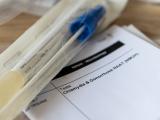European health officials are warning that three recently reported cases of extensively drug-resistant (XDR) gonorrhea highlight an emerging global threat and indicate a need for action to preserve the last remaining effective treatment for the infection.
In a Rapid Risk Assessment published yesterday, the European Centre for Disease Prevention and Control (ECDC) said the three cases of XDR Neisseria gonorrhoeae reported in the United Kingdom and Australia are the first global reports of gonorrhea with resistance to ceftriaxone and high-level resistance to azithromycin, along with resistance to several other antibiotics. The dual therapy of ceftriaxone and azithromycin is the recommended first-line treatment for gonorrhea, which has developed resistance to most other antibiotics.
"These events give significant cause for concern considering the lack of alternative treatments for gonorrhoea," the authors of the report wrote.
Concerns about treatment failure
The three cases, one in the United Kingdom and the others in Australia, were initially reported in March and April. In the UK case, an isolate with resistance to ceftriaxone and high-level resistance to azithromycin was identified in a heterosexual man with a regular female partner who had sexual contact with a woman in Southeast Asia a month prior to symptom onset. The two Australian cases also involved men, one of whom reported having acquired the infection from a sex worker in Southeast Asia.
In all three cases, which were not epidemiologically linked, the bacterium was susceptible to other drugs. The UK patient was cured after 3 days of treatment with intravenous ertapenem. The isolates from the Australian patients were reported to be susceptible to gentamycin and spectinomycin. But the ECDC report notes that there is limited evidence on the efficacy of gentamicin and ertapenem in treating gonorrhea, and that N gonorrhoeae has the potential to develop rapid resistance to spectinomycin.
Gonorrhea strains with either high-level ceftriaxone resistance or high-level azithromycin resistance have been reported in a handful of countries in recent years, but the identification of strains that don't respond to either drug raises the level of concern about treatment failure, given that N gonorrhoeae has developed resistance to most other antibiotic classes. Serious complications from gonorrhea infection, including pelvic inflammatory disease and infertility, could increase without adequate treatment.
The agency warned that the spread of these XDR strains would threaten the effectiveness of the currently recommended dual therapy, would increase the reliance on antibiotics with limited data of effectiveness, and would ultimately lead to more cases of gonorrhea, since effective treatment is one of the main methods of control. Gonorrhea is the second most common bacterial sexually transmitted infection in Europe, with more than 75,000 cases reported in 2016.
Options for response
To prevent the spread of XDR strains and preserve ceftriaxone and azithromycin as effective treatment options, the ECDC report concluded that clinicians, microbiologists, epidemiologists, and public health officials need to collaborate better.
The authors said the response should start with prevention efforts focused on measures to reduce the overall number of gonorrhea cases, including the promotion of safer sex practices. Since two of the cases were travel-related, they also suggested information on safer sex practice should be considered as routine advice for travelers.
Other recommended steps include ensuring that all gonorrhea cases are promptly diagnosed and managed according to national and international guidelines and tests-of-cure are performed, communicating results from antimicrobial resistance surveillance to increase awareness of the threat of drug-resistant gonorrhea, and reminding gonorrhea patients of the importance of partner notification. The ECDC also urged clinicians to pay more attention to the effective detection and treatment of pharyngeal gonorrhea, which is more difficult to eradicate than urogenital infections.
On an international level, the ECDC called for stronger antimicrobial resistance surveillance for N gonorrhoeae and more timely sharing of treatment failure data. "Timely antimicrobial resistance profiles with sufficient epidemiological information will enable early detection and investigation of treatment failures, and will inform national and international treatment guidelines," they wrote.
The ECDC said the cases highlight the need for the development of new antibiotics and an effective vaccine for gonorrhea treatment and prevention. Three antibiotics are currently in clinical development, but a vaccine remains a long way off.
The World Health Organization warned in July 2017 that widespread gonorrhea treatment failure will emerge in the coming years unless new antibiotics are developed. The agency has identified the bacterium as a high-priority target for drug development.
See also:
May 7 ECDC Rapid Risk Assessment
Mar 28 CIDRAP News story "In world first, UK reports high-level gonorrhea resistance"
Apr 20 CIDRAP News scan "Good news about UK 'super gonorrhea' case—but 2 new infections noted"
Jul 6, 2017, CIDRAP News story "Global officials warn of pan-resistant gonorrhea"























